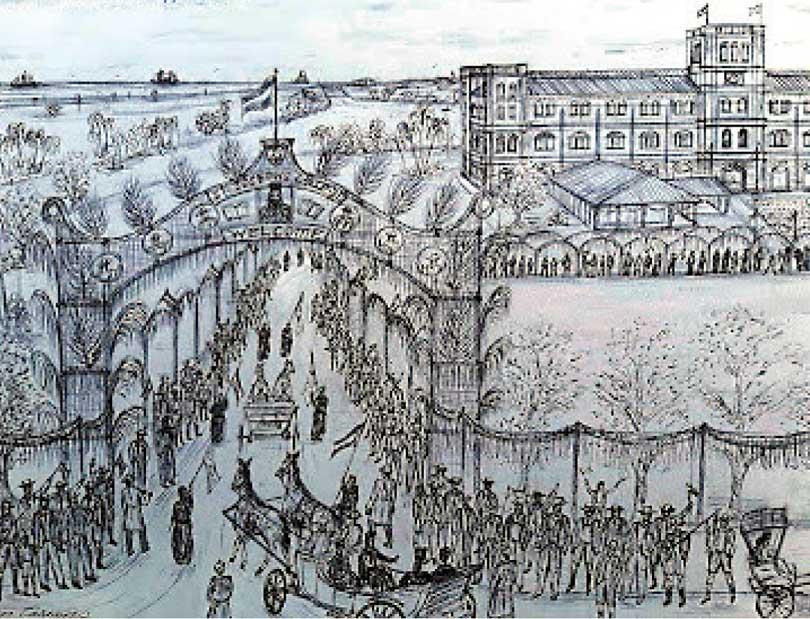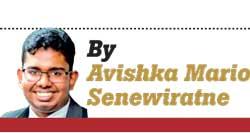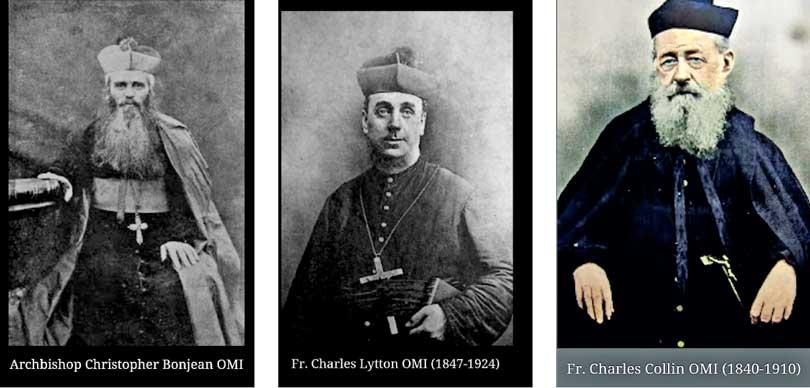Reply To:
Name - Reply Comment
Last Updated : 2024-04-20 00:00:00

The grand opening of St. Joseph’s College on Saturday, November 28, 1896.
Illustrated by Kevin Caspersz
 St. Joseph’s College, Colombo is a citadel of education established by the pioneering and painstaking efforts of the missionary Oblates from Europe and the significant contribution of the Catholic community of Colombo, in the late 19th Century. Ever since the British declared freedom to practice any faith after overthrowing the Dutch, who oppressed Catholics for 150 years, the need for Catholic schools arose. During this time the only Catholic religious group were the Oratorian missionaries from Goa, who were the successors of St. Joseph Vaz. Though its vehemently accepted that these missionaries were highly pious and pastoral, they did not have adequate expertise to establish schools. However, when Msgr. Orazio Bettacchini, an Italian Oratorian was made the Vicar of Jaffna, he understood the burning issue in Ceylon and approached the Propaganda Fide in Rome, to send missionary groups to start schools. Thus, within the next two decades, Oblates, Benedictines, Good Shepherd Sisters and the La Sallian brothers would arrive in Ceylon. This plan worked well. All around Ceylon, Colleges and Convents of the highest calibre were built.
St. Joseph’s College, Colombo is a citadel of education established by the pioneering and painstaking efforts of the missionary Oblates from Europe and the significant contribution of the Catholic community of Colombo, in the late 19th Century. Ever since the British declared freedom to practice any faith after overthrowing the Dutch, who oppressed Catholics for 150 years, the need for Catholic schools arose. During this time the only Catholic religious group were the Oratorian missionaries from Goa, who were the successors of St. Joseph Vaz. Though its vehemently accepted that these missionaries were highly pious and pastoral, they did not have adequate expertise to establish schools. However, when Msgr. Orazio Bettacchini, an Italian Oratorian was made the Vicar of Jaffna, he understood the burning issue in Ceylon and approached the Propaganda Fide in Rome, to send missionary groups to start schools. Thus, within the next two decades, Oblates, Benedictines, Good Shepherd Sisters and the La Sallian brothers would arrive in Ceylon. This plan worked well. All around Ceylon, Colleges and Convents of the highest calibre were built.
St. Benedict’s Institute, Kotahena started by the Benedictines initially and to date run by the La Sallian Brothers is without doubt the pioneering English Catholic School in Colombo. Though having an excellent reputation for English and Science Education, St. Benedict’s did not have scheme of teaching Classics. This was because the La Salian brothers were prohibited from teaching it. On the other hand, the British run Government in Ceylon made it a mandatory rule that Civil Servant applicants must specialise in Classics. This severely affected the Catholics in Colombo, that some even when to admit their children to non-Catholic schools to study Classics.
Archbishop Bonjean’s efforts
During this time, Archbishop Christopher Bonjean OMI was the head of the Archdiocese of Colombo. Ever since his first coming to Jaffna as a missionary his forte had been education. He too had the idea of starting a new Catholic school under the Oblates. With the issue of Classics in hand, the layman made a strong request to the elderly Archbishop to start a college, where Classics would be taught. The Archbishop had no objection for this request, but had many factors lacking in order to start a school of this nature. He lacked English educated missionaries, the substantial funds to purchase property and erect buildings and a staff qualified in Classics. Though Archbishop Bonjean made frequent visits and requests to his superiors in Rome, the results were always negative, delaying the work to start such a school. Not giving up on this idea, the Archbishop came up with a strategic plan. He requested the Bishop of Jaffna, Andrew Melizan OMI, to transfer one of his priests to Colombo. This was the Irish Oblate, Fr. Charles Henry Lytton OMI. Fr. Lytton had a reputation as a go getter. It was he who advocated the need for a Railway Link to the North and it was he who brought St. Patrick’s College, Jaffna to an excellent standard. Above all things, Fr. Lytton being a true Irishman, had the grit and courage to oppose and challenge the British. Archbishop Bonjean also appointed another Oblate, Fr. Thomas Guglielmi OMI to assist Fr. Lytton in his task. Soon by January 1892, a pastoral letter was issued by the Archbishop of Colombo, stressing on the need to start a school and encouraging all those who can to contribute generously.

Oblates and Layman at work
As a result, a large meeting was held for prominent Catholics in Colombo at St. Mary’s Church, Maliban Street, Pettah (This church doesn’t exist today). The meeting was spearheaded by Fr. Lytton. Deeply interested after Fr. Lytton explained the task in hand and understanding what importance such Catholic school could do the Country, many volunteered to fund the project. Advocate C. Britto and John Clovis de Silva topped the lists of benefactors by donating an outright sum of Rs. 5000 each. With funds pouring in, the priests had enough money to buy a land. The land selected was somewhere close to the Colombo harbour called ‘Uplands’. However, the British Government requested the church to sell them the property, after they found how valuable it would be in expanding the harbour. To make matters worse it was during this time Archbishop Bonjean passed away. The next few months Fr. Lytton and the British Governor had acrimonious talks on whom the property should go to. Matters got serious and the two had to make a trip to England and sort the case with the Colonial Secretary. Though Fr. Lytton never compromised on any deal by the Governor, he had to finally give up as the Colonial Secretary decided that the land must be taken over by the Governor.
Fortunately, the purchase sum of Rs. 60,000 was returned. The process of starting the school was heavily stalled as Archbishop Bonjean was no more. However, the new Archbishop of Colombo, Andrew Melizan supported the cause by 1894 and decided that the original team along with his Vicar General, Fr. Charles Collin OMI, must accomplish this timely endeavour.
The Lake House and the Clock Tower
With the purchase of a famous property called ‘Lake House’ between Darley Road and the Beire Lake, the plan began to show better results. Orabi Pasha, the famed Egyptian revolutionary had once resided in ‘Lake House’. A grand ceremony was organised by the committee in December 1894, with Msgr. Ladislaus Zaleski, the Apostolic Delegate to the East Indies, to lay the Corner stone of the first building of the proposed school. It was during this time that Archbishop Melizan decided to name the school under the patronage of St. Joseph. While funds were collected, the Oblates in Rome finally by 1895, sent Oblate priests to Ceylon, who had much expertise in English and education. Some of these European fathers, were of aristocratic backgrounds. Yet, true to their vow of poverty, selflessly went all around the Archdiocese to spread the awareness of the new school and even appealed to their families back in Europe to fund the building, which was now being constructed.
The first building of St. Joseph’s College was a monumental one. Standing three-storeys high with four towers in each corner and one singular tower at the centre with a clock and Carillion bells, was a spectacular view. Fr. Charles Collin and the Oblates quickly came to reside at the Lake House Bungalow, which had been built by the previous owners. With the fathers stationed in Lake House, they overlook the gigantic task at hand. Within a year, the edifying, majestic look its designers predicted came to existence. The people in Maradana, were stunned to see such a picturesque structure being completed. On the other hand, Fr. Lytton was busy in Europe finding teachers who were experts in Classics. He knew as the late Archbishop and the people of Colombo needed to stress of Classics, the subject had to be taught in best possible standard. In December 1895, three teachers arrived in Colombo by ship to join the staff of the nearly completed school. These were Messrs Maxwell Drennan, Pope and Hughes. All three of them would be recruited by reputed Western universities in the subsequent years.
When one section of the building was fully constructed, it was decided that the school should open on March 2, 1896. With Fr. Collin as Rector and Fr. Lytton as Vice-Rector, that day 307 students joined as the first batch of Josephians. To this date, St. Joseph’s College celebrates March 2nd, as the day the school started. However, by this point St. Joseph’s had not been blessed or declared open as the other section of the Clock Tower Building was still being constructed. Those early days the school functioned were much difficult as the teachers and students struggled with sounds of construction going on continuously. By November, 1896, the Clock Tower Building was completed. The Rector decided that it was time ceremoniously declare the College open. The programme was arranged for two days; the first day to be the blessing ceremony by the Apostolic Delegate and the next day to be opened by the British Governor.
The Ceremonial Opening – November 27-28, 1896
November 27, 1896, was set as the day to bless the new college. Unfortunately, Archbishop Melizan had fallen gravely ill and was in Europe till he recovered. To represent him, the Bishop Clement Pagnani O.S.B. of Kandy and Bishop Joseph Van Reeth SJ of Galle along with the Apostolic Delegate of the East Indies, Msgr. Zaleski graced the solemn occasion to bless the school. 59 Catholic priests, a vast number of dignitaries and representatives of all religions and faiths were present as well. At the entrance to the school a giant pandal was erected and the College Blue and White flag along with the Papal flag stood in harmony for the very first time. The bishops blessed the classrooms and halls, concluding the event with a prayer service. The next day, Saturday, November 28, the same dignitaries, well-wishers and students gathered again in the premises to welcome Governor Sir Joseph West Ridgeway, along with Capt. Marque and Sir Solomon Dias Bandaranaike, the Mahamudaliyar. That evening over 500 horse carriages and a greater number of rickshaws were parked at the school premises indicating the interest of the community to participate in this historic event. The governor solemnly declared open St. Joseph’s College that evening and with much hurrah and cheer. A memorable firework display was set to conclude the event spectacularly.
These events happened exactly 125 years ago. Throughout its lifetime, St. Joseph’s College has strived and succeeded in excellence and triumphs. The zealous personalities ranging from Rectors, teachers and students over the past 125 years, have made this College historically significant. Their self-effacing service not just to the College but extending to Society has been written in letters of gold. The examples of the past of this glorious College and its personalities must be repeated over and over, and alumni nourished with virtue and knowledge must be produced, till the mountains disappear.
avishkamario@gmail.com
(Special thanks to Mr. Francis D’Almeida.)
Robert Abayasekara Tuesday, 30 November 2021 10:59 AM
An well researched excellent article. I had heard before that the College was established to compete with other leading Colleges's, but never knew why.
Lakshman Jayasekara Tuesday, 30 November 2021 09:52 PM
Very well researched

Add comment
Comments will be edited (grammar, spelling and slang) and authorized at the discretion of Daily Mirror online. The website also has the right not to publish selected comments.
Reply To:
Name - Reply Comment
On March 26, a couple arriving from Thailand was arrested with 88 live animal
According to villagers from Naula-Moragolla out of 105 families 80 can afford
Is the situation in Sri Lanka so grim that locals harbour hope that they coul
A recent post on social media revealed that three purple-faced langurs near t